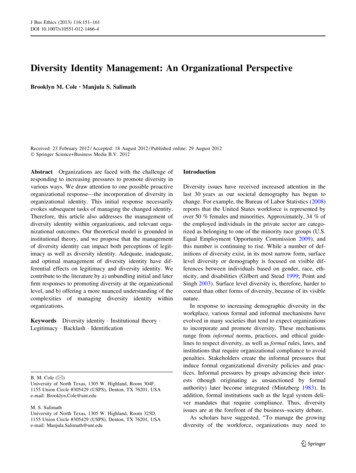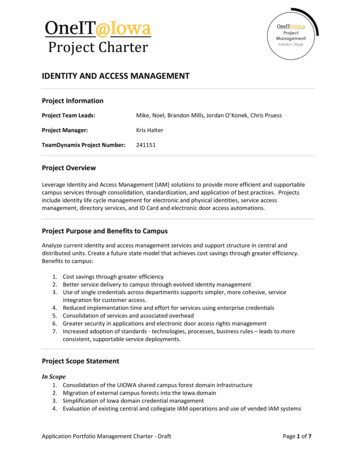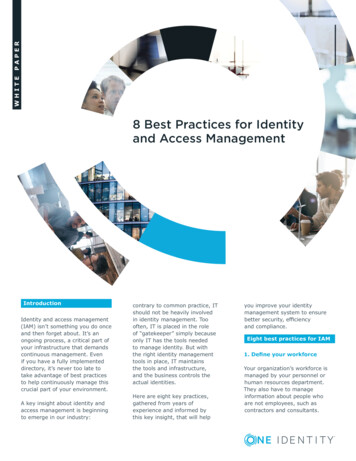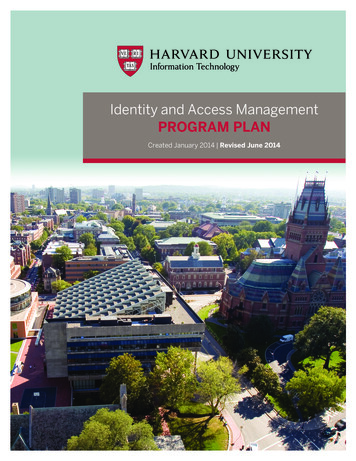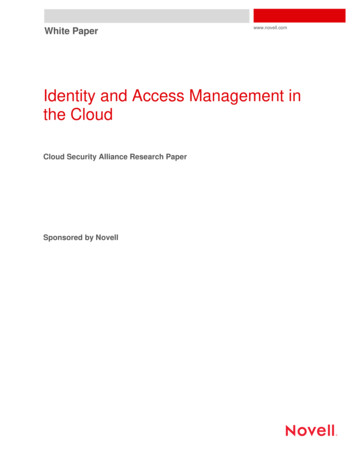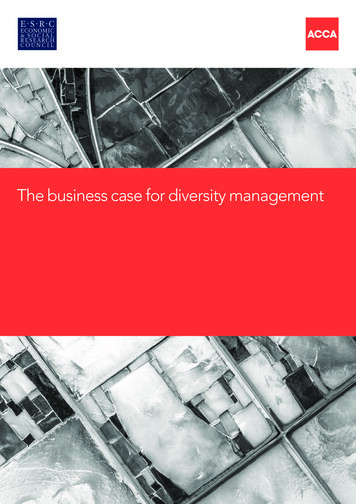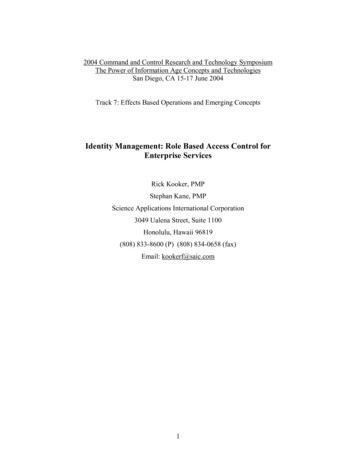
Transcription
Identity, Diversity and Diversity ManagementOn Theoretical Connections, Assumptions and Implications for PracticeHolck, Lotte; Muhr, Sara Louise; Villeseche, FlorenceDocument VersionAccepted author manuscriptPublished in:Equality, Diversity and InclusionDOI:10.1108/EDI-08-2014-0061Publication date:2016LicenseUnspecifiedCitation for published version (APA):Holck, L., Muhr, S. L., & Villeseche, F. (2016). Identity, Diversity and Diversity Management: On TheoreticalConnections, Assumptions and Implications for Practice. Equality, Diversity and Inclusion, 35(1), 48-64.https://doi.org/10.1108/EDI-08-2014-0061Link to publication in CBS Research PortalGeneral rightsCopyright and moral rights for the publications made accessible in the public portal are retained by the authors and/or other copyright ownersand it is a condition of accessing publications that users recognise and abide by the legal requirements associated with these rights.Take down policyIf you believe that this document breaches copyright please contact us (research.lib@cbs.dk) providing details, and we will remove access tothe work immediately and investigate your claim.Download date: 14. Jun. 2021
Identity, Diversity and Diversity Management: OnTheoretical Connections, Assumptions and Implications forPracticeLotte Holck, Sara Louise Muhr, and Florence VillesécheJournal article (Post print version)This article was originally published in Equality, Diversity and Inclusion: An International Journal,Vol. 35, No. 1, pp. 48-64.DOI: http://dx.doi.org/10.1108/EDI-08-2014-0061Uploaded to Research@CBS: Januar 2016
Identity, diversity and diversity management: On theoreticalconnections, assumptions and implications for practiceAbstractPurpose: We examine the relationship between the identity and diversity literatures anddiscuss how a better understanding of the theoretical connections between the two informsboth diversity research and diversity management practices.Design/methodology/approach: Literature review followed by a discussion of the theoreticaland practical consequences of connecting the identity and diversity literatures.Findings: We inform future research in three ways. First, by showing how definitions ofidentity influence diversity theorizing in specific ways. Second, we explore how suchdefinitions entail distinct foci regarding how diversity should be analyzed and interventionsactioned. Third, we discuss how theoretical coherence between definitions of identity anddiversity perspectives – as well as knowledge about a perspective’s advantages andlimitations – is crucial for successful diversity management research and practice.Research limitations/implications: We argue for a better understanding of differences,overlaps and limits of different identity perspectives, and for a stronger engagement withpractice.Practical implications: Our work can encourage policy makers, diversity and HR managersto question their own practices and assumptions leading to more theoretical informeddiversity management practices.Originality/value: The theoretical connections between identity and diversity literature haveso far not been reviewed systematically. Our work foregrounds how important it is fordiversity scholars to consider identity underpinnings of diversity research to help furtherdevelop the field within and beyond the three streams we discuss.KeywordsIdentity, diversity, diversity management, HR diversity practices.Paper typeLiterature review1
IntroductionDiversity scholarship has for many years discussed the way we perceive, treat and managepeople’s differences such as demographic differences in the work force, behavioraldifferences between and among cultural groups, as well as the intersection of such differences(see for example Holvino and Kamp 2009; Ghorashi and Sabelis 2013; Jonsen et al., 2013;Janssens and Zanoni, 2014). As these differences are ascribed to an individual – or a group ofindividuals – diversity theory is linked to the way individuals are perceived and constructedby themselves and others. Such a construction and perception of the self has been the focus ofthe interdisciplinary research field on identity. Identity theories aim at understanding how weseek to answer the existential questions “who am I?” and “how should I act?” (see forexample Alvesson et al., 2008).Identity can be considered as construction of the self that rests on an alteration, or ‘otherness’construction: “Who am I not and how am I different? How am I different and from who? Howam I similar and from who?” (Czarniawska, 2007, p. 4). Thus, dealing with the issue ofdiversity is always closely linked to individuals experiencing their own identity as ‘beingdifferent or not’ in a particular context. Moreover, identity construction does not happen in anarbitrary vacuum. When constructing their identity, individuals draw on social identitiesand/or discourses available in their social environment. This shapes how they act and howthey interpret events (Kenny et al., 2011; Toyoki and Brown, 2014; 2013; Roberson, 2006;Weick et al., 2005). Hence, identity and identification are central concepts when aiming tounderstand diversity.Whether diversity or ‘difference’ are defined in essentialist terms (considering specificindividual traits or socio-demographic groups as the basis for diversity and/or identitydefinition) or whether identities and diversity are viewed as socially constructed in specificand dynamic contexts (Tatli and Özbilgin, 2012) thus has important implications. Diversityand identity literatures are profoundly intertwined in ways often not explicitly acknowledgedby diversity scholars, especially within the diversity management literature, i.e. the part of thediversity literature explicitly concerned with the practical application of how differences areand should be managed in organizations, and to what ends (e.g. Holvino and Kamp, 2009;Tatli and Özbilgin, 2012). In practice, the presumptions about identity with which HR, middlemanagers and other diversity managers approach matters of diversity have practicalimplications regarding the definition of who is the target group of diversity interventions, onwhich criteria of sameness/difference distinctions these interventions are based, and whether2
‘the business case’ or social justice/moral intentions guide the rationales behind diversityinterventions (Tomlinson and Schwabenland, 2010; Oswick & Noon, 2014; Kamp andHagedorn, 2004).We suggest that, while authors and practitioners may have specific positions on how theyview diversity or engage with data from organizations that developed diversity policies basedon certain assumptions about identity, these identity positions and assumptions are rarelyaddressed frontally. We suggest that this lack has led to a fragmented diversity literature thataddress the issue of diversity in organizations from different identity perspectives, and withdifferent aims. Furthermore, we see the relative absence of acknowledgement of identitytheory underpinnings and the presence of these ‘fault lines’ as preventing a more fruitfuldialogue across diversity perspectives, but also between researchers and practitioners. Thepaper is structured as follows: We start by introducing identity theory and detailing threeoverarching perspectives, their translation and application in the field of diversity, as well asthe limits of each approach. Acknowledging the limits of dividing a large field into three suchsub-themes, we then propose a discussion of how our review – and tripartition – cancontribute to developing fruitful research in the field of diversity, and ultimately impacteveryday practices of diversity management in organizations.Linking identity and diversity literaturesIdentity is a broad and multidisciplinary topic, and as such has been studied from variedperspectives, which have themselves been classified and labeled differently across time anddisciplines (see for example Kenny et al., 2011). However, some key dichotomies arerecurrent, such as “the extent to which identities are chosen or ascribed, stable or dynamic,coherent or fragmented” (Brown, 2014, p.4). In this article, we read existing diversityscholarship along the continuum from the one to the other constituent of these dichotomies.Although there are obvious limitations to doing so, in particular as it is at times impossible toassign a given article to one perspective and because streams can overlap, we will for theanalytical purpose of discussing the theoretical links between the identity and diversityliteratures divide identity literature into three perspectives: Social Identity Theory (andsimilar) perspectives; critical perspectives on identity; post-structural perspectives on identity.A broad partition, beyond its limitations, is a relevant way to make sense of a very large bodyof literature about identity with regards to a specific focus (Ramarajan, 2014), here the ties ofidentity scholarship(s) with diversity literature.3
Coherent and unified identities - Social Identity TheorySocial Identity Theory and similar perspectives view the identity of a person as having a corethat is specific and fixed for each individual; one that is unified (Brown, 2014; Ybema et al.,2009). Identity develops as a personal (ideally coherent) sense of self, which is extremelyimportant for how any individual sees him or herself as well as engages with others. A majorapproach derived from this line of thinking is Social Identity Theory (SIT), which wasintroduced in the 1970s in the field of social psychology by Tajfel and Turner (e.g. Tajfel andTurner, 1985). Some groups are more relevant and salient to the self-concept than others, andthese relevant groups constitute social identity (van Tilburg and Igou, 2011; Dokko et al.,2013; Brewer et al., 2010; Deaux, 2001).Social identity expands one’s sense of self at the group-level: by means of socialidentification processes, we define ourselves in terms of categories that we share with otherpeople, and social identity theory presumes commonalities with others based on rather fixedcategories (Tran et al., 2010; Deaux, 2001). In an organizational context such sociopsychological group processes are used to explain organizational phenomena such asinclusion and exclusion, the formation of in- and out-groups, and ‘similarity attraction’ inworkgroup and team formation (Shore et al., 2011; Tran et al., 2010; Ellemers, et al., 2002).The formation of these groups – and the corresponding categories that are formed based onsuch group formation to classify whether people belong or not – help organizational membersnavigate the complexity of stimuli in social relating as a certain ordering is enforced,providing members with systematic means of defining others and to locate oneself (Ashforthand Mael, 1989). This means that SIT is composed of, on the one hand, characteristics that arefixed and tied to the self, such as phenotypical attributes or values, and, on the other hand, of“a social identity encompassing salient group classifications” (Ashforth and Mael, 1989, p.21) that can be multiple, for example identification as a woman, as an accountant, or as aDane.SIT perspectives in diversity research – managerial argumentsWithin a SIT conceptualization of categories, the focus has been on demographic attributes, inparticular race and gender, as they are deemed the strongest predictors of group formation inorganizations. For example, part of the literature presents findings claiming that genderrepresents not only surface level characteristics but also refers to deep-level differences (e.g.Harrison and Klein, 2007; Jehn et al., 1999) such as differences in values (Gove, 1994; Weberet al., 2009). Such differences in values are important because value similarities have been4
shown to be positively associated with social attraction (McGrath, 1984) and group memberinteraction (Thibaut and Kelley, 1959).The topic of racial/ethnic diversity is predominant in the field of social psychology orcognitive psychology. In relation to diversity research, some of the more frequently citedtheories – apart from SIT – include a wide range of related theories such as intergroup theory(Tajfel and Turner, 1985), social- and self-categorization theories (Pettigrew, 1986; Tajfel,1981), the similarity-attraction paradigm (Byrne, 1971; Lazarsfeld and Merton, 1954), andtokenism and proportionality theories (Kanter, 1977; Oliver et al., 1985). Studies in line withsuch theories have been used to consider negative predictions and outcomes of race/ethnicity(Mamman et al., 2012; Shore et al., 2009) or gender differences on, for example,organizational processes, performance, or innovation (Adams and Fereirra, 2009; Lauring andSelmer, 2010). Other studies consider positive predictions in relation to ‘valuing diversity’and the ‘business case’ claiming that diversity leads to positive outcomes such as bottom-linegains, improved corporate image, enhanced problem solving ability, or increased team andorganizational learning (Cox, 1993; Thomas and Ely, 1995). A popular example is theliterature stream examining the effect of women directors on firm performance (Hoogendoornet al., 2013; Lückerath-Rovers, 2011).Critique of SIT inspired diversity literatureSIT-inspired work in the field of diversity is underpinned by an assumption that ‘salient’diversity categories are fixed, stable, and analyzable, and as such transcend time and place –and are therefore barely changeable (Benschop and Van den Brink, 2013; Tatli and Özbilgin,2012; Jonsen et al., 2011; Boogaard and Roggeband, 2009). SIT grants the individual someautonomy in relation to identity formation by being able to identify with different groups(unified but not unitary selves), but simultaneously it produces a rigid perception of identityas having a fixed and permanent core, assuming that as long as people can be classified andmapped, they can be better managed. Beyond this limit, it means we evade the issue ofchanging historical perceptions of for example age or gender. It follows that the SITperspective largely ignores the complexity of shifting and multiple forms of identification thatpeople draw on in changing situations and contexts (Calás et al., 2012), and therefore makespositive social transformation difficult (Kenny et al., 2011). Another key critique of the SITperspective is the element of ‘depersonalization’, i.e. of seeing the self as an embodiment ofthe in-group prototype, as argued for example by Alvesson (2010). This can lead to5
privileging the group or organization as a source of identity whilst assuming that the waydifferent individuals perceive themselves and their group/organization is comparable.This is also what Tatli and Özbilgin (2012) identify as an ‘etic’ approach to diversity based onpre-established and pre-fixed (ex ante), rather than emerging categories of difference. Thisessentialist approach to diversity studies is often combined with a single-category focus (e.g.gender, race or ethnicity, or age), thus overlooking the role of the intersections of multipleforms of difference. In addition, it often lacks a sense of context and thereby disregards thedynamic nature of power and inequality relations. Although easily applicable and also usefulfor given analytical designs, this can lead to oversimplification and stereotyping – eitherreinforcing stereotypes by the tendency to combine ‘difference’ with otherwise marginalizedgroups on the labor market, or as a means to gloss over and ‘dissolve differences’ in pursuit ofcorporate integration and profitability (Tatli and Özbilgin, 2012; Zanoni et al., 2010;Lorbiecki and Jack, 2009). This has led to an oscillation between ‘colorblind diversitypolicies’ in the quest to overcome resistance or ‘identity conscious’ in the quest for socialjustice and articulation of historically based structural and power related inequalities (Tran etal., 2010).Floating identities – a critical perspectiveThe fixing of categories can be a political strategy for practitioners. If working in and againsta system built upon the privileges and rights related to certain fixed identities, then theuncovering of privilege can be converted into political actives, creating group solidarity as apoint of departure for mobilization of pressure to change (Staunæs, 2003, p. 103). FollowingClarke et al. (2009), identity construction should be seen as a dialectic process betweenstructure and agency: “[ ] while identities are achieved rather than ascribed, such identitiesmay not always be of your own choosing” (Clarke et al., 2009, p. 347). This is in line with theidea that individual, collective and organizational identities can be seen as dynamic, openended and polyphonic identity construction processes (cf. Hatch and Schultz, 2002;Humphreys and Brown, 2002).It is this sensitivity to both conventional social categories and identity regulation intersectingwith a greater open-minded effort to explore identity work and reflexive identity that thecritical perspective explores (Bardon et al., 2014; Giddens, 1996; Kuhn, 2006; Sveningssonand Alvesson, 2003). This position navigates between on the one hand identity regulationconcerned with frames of discourses that provides scripts, roles and subject positions suturingpeople in social structures, and on the other identity work concerned with the actors’ efforts to6
create a coherent sense of self in response to the multiple and perhaps conflicting scripts,roles, and subject positions encountered in organizational relations (Alvesson and Willmott,2002; Kuhn, 2006; Weber and Glynn, 2006). The critical perspective thus distances itselffrom the SIT perspective by examining what external dimensions of power and discourseinfluence the subject in ways that renders the individual autonomy – assumed by SIT –impossible. The critical perspective also has an emancipatory agenda as such views onidentity lead to investigations of various ways identity regulation can be used as managerialcontrol mechanisms (Alvesson and Kärreman, 2004; Muhr et al., 2013).Critical perspectives in diversity literature – social justice for minorities and the lessprivilegedTo make up for the ‘flaws’ of an essentialized static account of diversity rooted in SIT, an‘emic’ approach (as opposed to the formerly mentioned ‘etic’ approach) based on emergingand situated, rather than pre-determined, categories of diversity has been proposed (Tatli andÖzbilgin, 2012). This conceptualization of emergent, intersectional and relational identities iswell established within critical diversity literature (e.g. Calás et al., 2012; Kenny and Briner,2014). The critical diversity literature has in particular been focused on deconstructing andde-essentializing the notion of diversity to demonstrate how demographic categories andidentities are not to be seen as static and fixed but as socially constructed and under constantredefinition under the influence of competing discourses and existing structures of power(Knoppers et al., 2014; Lorbiecki and Jack, 2009; Van Laer and Janssens, 2011; Janssens andZanoni, 2005). The principle that underpins much critical diversity literature is therefore theseeking for social justice. In order to ‘unmask’ power dynamics, it is illustrated how diversitymanagement as a managerial practice can be a form of managerial control by definingminority employees in fixed, essential groups with negative connotations (see also Tatli andÖzbilgin, 2012; Ghorashi and Sabelis, 2013; Zanoni et al., 2010; Boogaard and Roggeband2009; 2000; Simon and Oakes, 2006; Roberson, 2006).In a critical perspective, organizational discourses such as the one on “diversity management”are considered to favor the normalizing of truth claims and other forms of organizationalindoctrination by organizing everyday conduct of the members (Fleming and Spicer, 2014;Muhr et al., 2013). In this way, the progressive rhetoric behind diversity management is‘unveiled’ as not only im
1 Identity, diversity and diversity management: On theoretical connections, assumptions and implications for practice Abstract Purpose: We examine the relationship between the identity and diversity literatures and discuss how a better understanding of the theoretical connections between the
